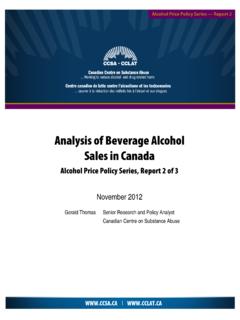Transcription of THE GLOBAL FOOD & BEVERAGE MARKET - UPA
1 SUMMER 2017 THE GLOBAL food & BEVERAGE MARKETWhat s on the Menu?4 / Cushman & WakefieldCONTENTS1. INTRODUCTION 62. CONSUMER TRENDS 83. GLOBAL OVERVIEW 144. THE MIDDLE EAST & AFRICA Key facts and figures Changing consumer lifestyles Case studies 235. THE AMERICAS Key facts and figures food Halls and restaurants in the USA Case studies 276. ASIA PACIFIC Key facts and figures Entertainment and gourmet food Case studies 317. EUROPE Key facts and figures Quality and variety of food : the key to success Case studies 358. OUTLOOK FOR THE GLOBAL F&B MARKET 379. CAVEATS & DEFINITIONS / 51. INTRODUCTIONThe GLOBAL food and BEVERAGE (F&B) MARKET has seen healthy growth over the last ten years and this is expected to continue. The proportion of comparison retail (clothing, footwear, white goods) as a percentage of total retail is decreasing and is being partially replaced by F&B, leisure and entertainment offerings in shopping malls, out-of-town retail parks and the main retail thoroughfares.
2 This is being driven by changing consumer shopping habits and the growth of experience retailing , reflecting consumers desire to enhance their physical shopping experience with a social/leisure experience. This is being seen, not just in the more mature retail markets in the US and Europe, but also in fast growing emerging markets in Asia Pacific and Middle East & , new shopping centre developments, refurbishments and extensions are increasingly being designed to include F&B and lifestyle areas, including stand-alone food stalls and kiosks. By establishing and/or expanding the F&B footprint in retail schemes, it provides landlords with an opportunity to increase footfall, consumer dwell time and, ultimately, spend. This is particularly important considering the challenges faced by bricks and mortar retailers from the growth in online retailing in recent years in some markets. Most forecasters suggest that the share of online purchases will rise further, increasing the pressure on landlords and retailers to be flexible and to develop new strategies to create shopping experiences that cannot be replicated with purchases bought online, while also meeting consumers desire for convenience and speed.
3 This report looks at key trends in the GLOBAL F&B MARKET , beginning with how consumer demands have been evolving and how retailers and shopping centre owners have responded to these changes. The report also provides an overview of the eating out markets in the key GLOBAL regions, along with expenditure forecasts, in addition to summaries of prominent case studies. The report concludes with an outlook for the MARKET and looks at some of the potential impacts of these trends on retail / Cushman & / 72. CONSUMER TRENDSWHAT DO TODAY S SHOPPERS REALLY WANT IN TERMS OF food & BEVERAGE OFFERS?With the continuing growth in the GLOBAL foodservice industry, trends that are apparent in the US and Europe begin to replicate themselves in markets around the world. While there may be differences in the minutiae, the trends are broadly the same wherever you go. Tastes and sensibilities are ever changing and are fuelling greater customization, a drive towards authenticity and more innovation.
4 As consumers travel more widely and experience new flavours and foods, a new wave of GLOBAL cuisines is emerging, driven by consumer curiosity and greater exposure to international foods and flavours, such as Filipino, Korean and African. Yet there is also a contradiction here in that while consumers want GLOBAL flavours and produce, they also want to connect on a more personal level with it. They want to know where the food comes from and how to be part of that local today are driven by a sense of exploration or simply fear of missing out, and are always on the hunt for new experiences. food & BEVERAGE operators still need to maintain the quality of their offer, while simultaneously increasing customer engagement through personalized offers and training staff to make ordering suggestions based on guests previously expressed preferences. Restaurants are providing novel, fun and memorable meals through pop-up restaurants, secret venues and entertainment-themed venues, offering customers a thrill for just finding the location.
5 Venues that typically place experience over food and drink, including sporting events and music festivals, are now upgrading their menus to complement the experience. Today s educated consumers expect a top-notch dining experience. This is particularly true at higher-end are increasingly looking for more healthy food , whether it is vegetarian, vegan, low-fat, low-calorie, gluten-free, or just prepared from fresh ingredients. More consumers have begun to follow special diets and want to enjoy these healthier choices both at home and when they are eating out. Quality and healthy are becoming increasingly consumer emphasis on freshness and quality, together with concerns about the environment and sustainability, is prompting local sourcing of ingredients by foodservice operators. While many consumers remain loyal to larger concepts like Starbucks, more coffee connoisseurs in urban locations are visiting smaller, artisan coffee shops.
6 Overall, however, consumers demand better coffee wherever they are, from fine-dining establishments to fast-casual outlets. The genesis of the food hall has given the opportunity to consumers to pick and mix , allowing consumers with different tastes to socialise together, to try out new types of food or eat old favourites. It gives the consumer the opportunity to design his or her own experience at varying price points. The whole spectrum will be on offer, from sit-down, white-linen tablecloths, upscale dining experiences to urban-street foods. In addition, there could also be a strong range of artisanal food vendors selling gourmet meats and cheeses, chocolates and vegetables and, potentially, culinary themed retail / Cushman & WakefieldToday s consumers know how, when, where and what they want, usually wanting access to restaurant fare wherever they happen to be, whether at home, at work, or someplace other than in a restaurant seat.
7 With so many restaurants vying for business, maintaining customer loyalty has become increasingly difficult. Delivery is a highly effective means for foodservice operators to cultivate such loyalty. Foodservice operators will not only pursue the traditional way to offer delivery, such as through an in-house delivery service. Some will collaborate with restaurant delivery aggregators, like Grub Hub, Deliveroo and Doorstep Delivery. Others will feature delivery in a completely different fashion, establishing takeout-only outlets to complement their table service is continuously going to be a disruptor from within the F&B sector and consumers and operators alike will adopt new ways of engagement with each other. The convenience of online ordering, online payments and digital loyalty reward programs will change the nature of how consumers relate to the F&B sector. It is early days but voice-recognition is going to become a bigger thing, for instance through Amazon s Echo, where customers can place an order from their home by simply using their voice.
8 This is all linked to the range of take-out and delivery options, delivering food to homes, offices and even reduction of food waste is a growing issue in more mature markets (albeit a lot less in some developing markets). Both restaurants and retailers are increasingly aware of this. For instance, Selfridges department store in London teamed up with New York s internationally acclaimed Blue Hill restaurants to bring their thought-provoking food waste pop-up, wastED, to Oxford Street. Other initiatives include Apps such as 11th Hour created by a Singaporean food stall hawker. The app shows users any discounted menu items on offer from restaurants and food stalls in Singapore before they close. Similarly, Too Good To Go offers unsold food from retailers and restaurants before closing. It has been downloaded million times in Europe and the US since its launch in 2015. / 9 More recently, F&B has been more widely distributed through a mall and other concepts have evolved, including the food hall.
9 There is also a move towards the creation of different zones within the mall, with the emphasis moving away from the food court. Increasingly, outside seating is also being provided. However, the re-purposing of real estate such as converting a shop unit to a restaurant is not necessarily the way forward, if it does not create the right environment for today s malls have to adapt to this changing food culture. HOW AND WHY HAS THE ROLE OF F&B CHANGED SINCE THE RISE OF THE SHOPPING MALL?Arguably the emphasis on this question is misplaced. The role of F&B in shopping malls has changed due to the changing nature of consumers and food as culture. food culture usually refers to the behaviour, attitudes, and beliefs as well as the networks and institutions surrounding the production, distribution, and consumption of food . Gone are the days when consumers shared their experiences with friends about the latest gig or CD. Nowadays they want to talk about their latest dining experience and will share it on social media with their malls have to adapt to this changing food culture.
10 By doing this, they will bring new relatively recently, the food & BEVERAGE offer in shopping malls was confined to food courts, with their common seating area surrounded by a plethora of fast food operators such as McDonalds, Burger King, KFC, Taco Bell and so on. Very few mall owners deviated from this pattern, until around ten years ago, when some decided to incorporate fast casual concepts. Now there is considerably more diversity in the food court offer and some landlords are rethinking and upgrading their food courts. Shopping malls are dominated by GLOBAL mainstream food brands that are appreciated by the mass MARKET . As these brands can afford to pay higher rents and operating expenses, they continue to proliferate even in the new generation of shopping malls. It would be easy to be too hard on shopping mall owners and their short term financial vision to explain why food areas are still a bit dull. Some food brands have a tendency to replicate their formats with little consideration given to the characteristics of local shoppers.







